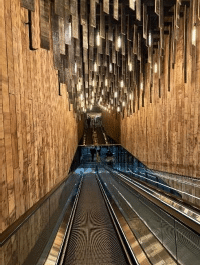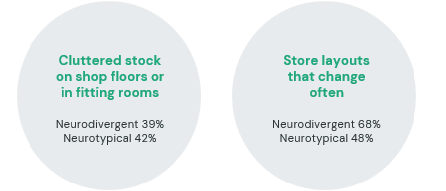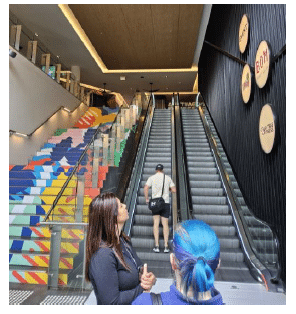One in five (1 in 5) Australians has a disability, of which 80-90% are not immediately obvious to others. Furthermore, an estimated 20% of the population identify as neurodivergent: people who have a neurology, (or brain wiring), that diverges from the neuromajority and that is characterised by differences in processing, sensing and communicating.
Neurodivergent identities are diverse and include: autism, dyspraxia, dyslexia, ADHD and dyscalculia. Acquired neurodivergence resulting from illness, accident and trauma, is also widely recognised under the neurodiversity umbrella.
Neurodivergent people navigate barriers in everyday life, including shopping. This article is a collaboration between Inclusive Change and Aspect and is part of a series designed to showcase the innovative solutions that Australian retailers are implementing to meet the needs of ALL shoppers. The article has been informed by feedback from the lived experiences of customers representing a range of neurotypes, and market research conducted by Inclusive Change and Nature.
In this article, we explore how retailers are creating accessible and inclusive shopping experiences by positively engaging the senses.

Image: Burwood Brickworks shopping precinct.
calming light installation above escalators
Reducing sensory overload in stores
Retailers have historically attracted customers into their stores through the senses – sound, lighting, and smells. Neurodivergent shoppers, many of whom have sensory systems that are extra sensitive to environmental stimuli, can find stores and shopping precincts a veritable minefield of sensory overload that may disrupt – and often halt – their shopping experience.
Research conducted by Inclusive Change and Nature has found that neurodivergent customers are significantly more challenged by sensory issues in physical retail settings, when compared to neurotypical customer). Of the 600 customers surveyed, 55% of neurodivergent respondents reported that competing noises in store was a barrier to shopping. Examples of competing noise include multiple music sources, trolleys, coffee machines, alarms, announcements, in-store radio.

While various technologies like decibel readers, light readers and heat mapping can be helpful for organisations in measuring some of the sensory aspects of the environment, they don’t adequately describe the neurodivergent experience. For example, decibel readers measure the overall volume, but not the quality of the sounds, the acoustics of the space, overlapping music and noises.
Neurodivergent respondents also reported that their shopping experience is significantly challenged when these competing noises overlap with other sensory inputs such as flashing screens or monitors, fluorescent lighting or excessive signage and smells.
Interestingly, neurotypical customers reported similar challenges with the sensory environment, just to a less intense extent, showing the importance of adapting the environment to be less overwhelming for all shoppers.

Providing positive sensory experiences
While sensory-sensitive people can often experience intense, negative experiences, the senses can equally be intensely enjoyable! In fact, activating the nervous system via the senses is a common strategy for feeling calm, happy or excited.
Neurodivergent people often use sensory input to regulate how they are feeling. This is known as ‘stimming’ (self-stimulatory behaviour) and can include any or all of the senses (smelling, touching, moving, listening, vocalising, looking). While everyone finds different things enjoyable, it’s essential that retailers provide positive sensory experiences, to help people stay regulated, including:
• flexibility and controllability, so that people can choose to engage in the way that works best for them (e.g. one incense smell at a time, variety of seating)
• opportunities to look at things that are typically beautiful or calming (e.g. fairy lights, art installations, plants, natural design elements)
• opportunities to move your body, feel deep pressure or feel different textures (e.g. inclusive playgrounds, massage chairs, sensory gardens)
• opportunities to engage in nature (e.g. sensory gardens, plants, natural design elements, sunlight, water play)
• calming or natural sounds
• products that focus on stimulating the senses, or avoiding negative sensations (e.g. fidget tools, seamless socks, tag-less clothing).
Quiet Rooms and Sensory Gardens
When sensory overwhelm does occur within retail spaces, there are often not many private, quiet and dignified areas to regulate. This often results in neurodivergent customers escaping to toilet stalls (which are not sensory friendly or dignified!), or just having to leave the shops without the items that they came for.
Shopping Centres like Stockland are now proudly developing designated Quiet Rooms, which are private, calm and comfortable spaces to de-stress before continuing shopping. Shopping Centres like Burwood Brickworks in Melbourne have developed parklands around the shopping centre, and have a rooftop working garden, providing spaces for customers to retreat and recuperate before continuing shopping.

What can Retailers do?
Some adaptations for existing stores can be cost effective and simple to implement. For new store builds, it is recommended that sensory experiences be considered upfront in the design phase so that spaces are comfortable and accessible from the outset. This will avoid the cost and complexity of store refits.
Shopping centres like Stockland and Mirvac – who are re-developing the Darling Harbour ‘Harbourside Project’ – are keenly incorporating neurodivergent design principles in their new builds.
Whether assessing existing stores or designing new spaces, it’s important to involve people with sensory differences. Increasingly, shopping centres and retailers are engaging organisations like the Aspect Autism Friendly team to have neurodivergent people:
• conduct sensory assessments of the environments
• give feedback about their experience
• make recommendations about adaptations
• check implementation of adaptations.

It’s vitally important to neurodivergent people that environments are less overwhelming. There are commercial benefits for:
• retailers, who are often missing out on a large group of shoppers
• retail staff who benefit from sensory-friendly stores
• customers who may respond to the calm environment with increased dwell time, strong brand loyalty and the size of their shopping cart.
Download the Neurodiversity In Retail report summary via www.inc-change.com.
Natalie Phillips-Mason is the Founder and Chief Ally at Inclusive Change, a pioneering change management neuroinclusion consultancy with a focus on education, consulting and research. Natalie is the member of a mixed neurotype family and works with a network of like-minded professionals to implement inclusive customer and employee experiences. Inclusive Change
Matt Oastler works for the Aspect Autism Friendly team, who specialise in supporting retailers to develop and deliver a range of sensory accommodations, resources and quiet hours. They have developed the Autism Friendly Built Environment Design Guidelines to help designers. Aspect.






















